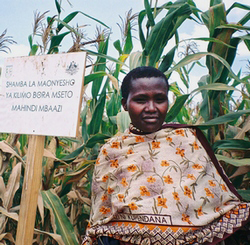 Through their own determination, and with support from local researchers, CIMMYT, ICRISAT, and organizations in Australia, sub-Saharan African farmers are applying improved maize-legume cropping systems to grow more food and make money.
Through their own determination, and with support from local researchers, CIMMYT, ICRISAT, and organizations in Australia, sub-Saharan African farmers are applying improved maize-legume cropping systems to grow more food and make money.
On a hot August day near the village of Kilima Tembo, and amid the sounds of barking dogs and clucking chickens, Felista Mateo stepped out of the house she built by hand, walked into her fields, and proudly admired her maize crop. The plants reached toward the sun, verdant and strong. Her plot stood in stark contrast to neighboring fields, which were pocked by brittle, knee-high plants.
A few years ago, things did not look so promising for Felista. She had separated from her husband and was left alone to care for her four children. Felista is a slight woman, not much more than five-feet tall, but her appearance belies her strength. Typically, a separated woman is ostracized when she returns to her parents’ home. Felista refused to see her newfound independence as an affliction. In Kilima Tembo, women do not own land, but Felista set out to acquire a plot from her father. She was determined to succeed. After the elders of the Village Council gave their approval, Felista became an independent farmer. It was this same strength of character that made her the perfect candidate for a new pilot program in the area.
| Maize-legume intercrops boost African farmers’ food security and incomes
Intercrops with legumes are popular among small-scale farmers in sub-Saharan Africa: they increase grain output per unit land area, help block weed growth, contribute to soil fertility, and reduce the risk of total crop failure. Launched in 2010, SIMLESA is a collaborative effort between CIMMYT (the International Maize and Wheat Improvement Center) and national agricultural research and extension systems in Ethiopia, Kenya, Tanzania, Malawi, and Mozambique, to improve the productivity of smallholder farmers growing maize and legume crops. Partners include the International Crops Research Institute for the Semi-Arid Tropics (ICRISAT), Tanzania’s Selian Agricultural Research Institute (SARI), the Association for Strengthening Agricultural Research in Eastern and Central Africa (ASARECA), the Agricultural Research Council (ARC) of South Africa, Murdoch University, and the Queensland Department of Employment, Economic Development and Innovation (QDEEDI) and Murdoch University. SIMLESA is supported by a grant from the government of Australia through the Australian Centre for International Agricultural Research (ACIAR). Activities include socioeconomic studies, market and value chain analysis, and directly involving farmers in the testing and selecting of crop varieties and conservation agriculture practices for tropical maize-legume intercropping systems. |
New intercrop fills her granary
Frank Swai is an extension agent with the Ministry of Agriculture who works with farmers and the Selian Agricultural Research Institute. He convinced Felista to plant a new kind of maize seed and advised her on better farming practices. Felista listened. She planted both the high-yielding maize Frank suggested and a tasty, early-maturing variety of pigeon pea. Neighbors were skeptical. Initially, Felista was the only one in the community who participated in the project. Villagers watched closely as Felista planted a crop never before seen in the area.
Months later, when it came time to harvest, it was clear Felista’s hard work had paid off. She grew enough maize to feed her children and had leftovers to sell in the market. “My yields have increased so much that I’m going to have to build a larger granary to store my harvest,” she said.
Enough to eat and export
Felista was aware that pigeon peas were exported directly to India, but in Tanzania farmers don’t sell directly to international markets. Instead, crops are sold through walanguzi, a pejorative term used to describe the middlemen who dominate the markets. Nevertheless, Felista retained some bargaining power with the middlemen by finding out actual market prices in India from Frank Swai, and by storing her harvest in her granary, waiting to sell until prices were high. Tanzanian farmers won’t ever be free of the walanguzi, but they can further their interests by banding together to get the lowest prices on inputs such as seed and fertilizer, and the most for their exports.
Her risk pays off
Felista is not your average Tanzanian farmer. Her hard work paid off. Had she failed, she may have been left trying to scrape together enough to survive. Tanzanian farmers like Felista have little margin for error. Initially, she planted three-fourths of an acre as requested by the pilot program. Next year, she plans to plant more. She now trusts the SIMLESA project and is willing to try new seed, different crops, and alternative farming methods. Others in the community have noticed. “My neighbors admire my crop since I planted the improved seed,” said Felista, as she waved a hand over her field, “and are also interested in joining the project.”
Felista waded into her field to pose for a photo. The maize towered above her head. A breeze whistled through the plants and she wrapped herself in a bright yellow kanga. As she steadied herself for the photo her eyes danced over her home and fields. A small, relieved look pushed up her face and then spread into a full, joyous smile.
For more information: Mulugetta Mekuria, CIMMYT Southern Africa regional liaison officer and SIMLESA project leader
(m.mekuria@cgiar.org)
See also:
New boost for maize-legume cropping in eastern and southern Africa
Simlesa’s most recent activites
 Climate adaptation and mitigation
Climate adaptation and mitigation